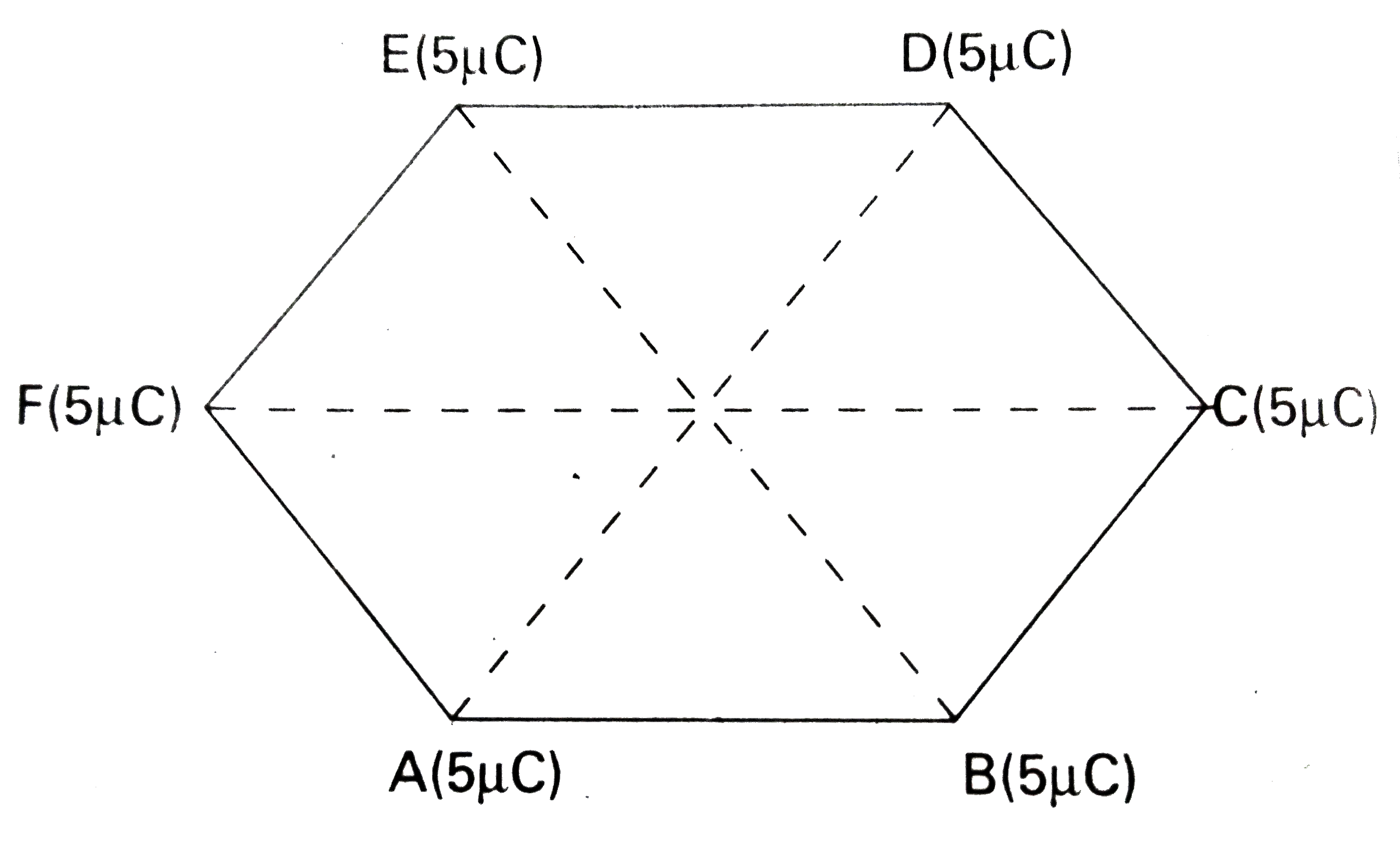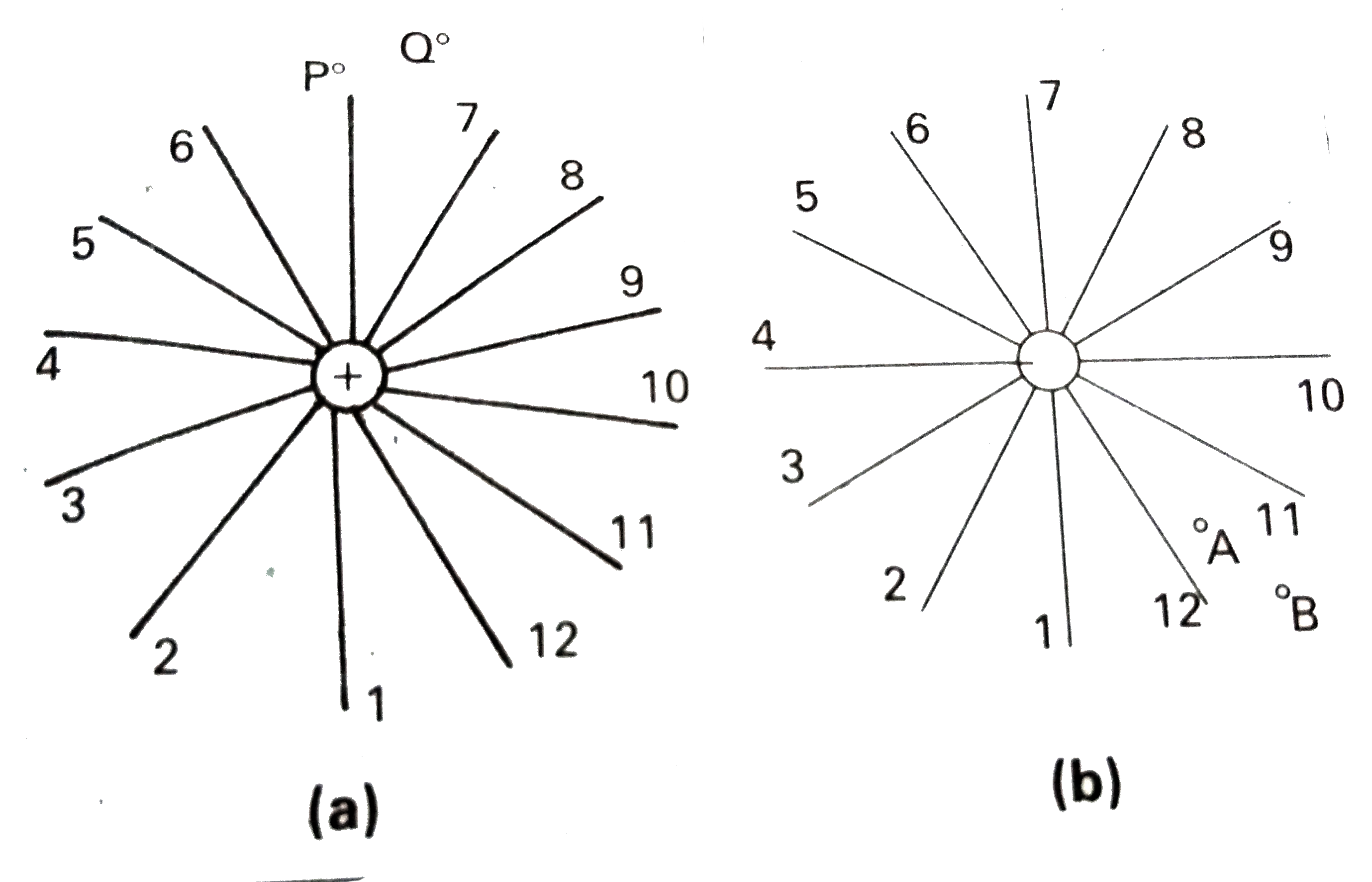A regular hexagon of side 10 cm has a charge 5μC each of its vertices, Calaculate the potential at the centre of the hexagon. Solution in Telugu
O is centre of hexagon. ABCDEFA of each side 10cm. As its clear from the figure, OAB,OBC etc. are equilateral triangles.
Therefore
OA=OB−OC−OD=OE=OF
=r=10cm=10−1m
As potential is scalar, there for C potential at O is

V=6×q4πε0r=9×109×6×5×10−610−1
=2.7×106V.
Topper's Solved these Questions
- ELECTROSTATIC POTENTIAL AND CAPACITANCEBook:VIKRAM PUBLICATION ( ANDHRA PUBLICATION)Chapter:ELECTROSTATIC POTENTIAL AND CAPACITANCEExercise:Additional Excercise
Explore 36 Videos
- ELECTROSTATIC POTENTIAL AND CAPACITANCEBook:VIKRAM PUBLICATION ( ANDHRA PUBLICATION)Chapter:ELECTROSTATIC POTENTIAL AND CAPACITANCEExercise:Textual Examples
Explore 10 Videos
- ELECTROSTATIC POTENTIAL AND CAPACITANCEBook:VIKRAM PUBLICATION ( ANDHRA PUBLICATION)Chapter:ELECTROSTATIC POTENTIAL AND CAPACITANCEExercise:Long Answer Questions
Explore 3 Videos
- ELECTROMAGNETIC WAVEBook:VIKRAM PUBLICATION ( ANDHRA PUBLICATION)Chapter:ELECTROMAGNETIC WAVEExercise:ADDITIONAL EXERCISES
Explore 19 Videos
- MAGNETISM AND MATTERBook:VIKRAM PUBLICATION ( ANDHRA PUBLICATION)Chapter:MAGNETISM AND MATTERExercise:Additional Exercises
Explore 19 Videos
Similar Questions
A charge of 8mC is located at the origin. Calculate the workdone in taking a small charge of −2×10−9C from a point P(0,03cm) to a point Q(0,4cm,0) Via a point R(0,6cm,9cm).
View SolutionFigure (a) and (b) shows the field lines of a positive and negative point charge respectively.

Give the signs of the potential difference Vp−VQ,VB−VA.
View SolutionDefine electric potential. Derive and expression for the electric potential due to an electric dipole and hence the electric potential at a point (a) the axial line of electric dipole (b) on the equatorial line of electric dipole.
View SolutionSuppose that the electric field part of an electromagnetic wave in vacuum is E={(3.1 N/C) cos [(1.8 rad/m)y+{5.4×106 rad/s} t]} i.
What is the direction of propagation ?
View SolutionWhy does a paramagnetic sample display greater magnetisation (for the same magnetising field) when cooled?
View SolutionFind the potential energy of a charge q0 placed at the centre of regular hexagon of side a, if charge q is placed at each vertex of regular hexagon ?
View Solution10 cm भुजा वाले एक सम-षट्भुज के प्रत्येक शीर्ष पर 1μC का आवेश है । षट्भुज के केंद्र पर विभव परिकलित कीजिए ।
View SolutionA hexagon of side 8 cm has a charge 4 muC at each of its vertices. The potential at the centre of the hexagon is
View Solution10 cm भुजा वाले एक सम - षट्भुजा के प्रत्येक शीर्ष पर 5μC का आवेश है | षट्भुजा के केन्द पर विभव परिकलित कीजिए |
View SolutionFour identical point charges, each of charge q, are placed on the vertices of a regular hexagon of side a such that the net electric field at centre of hexagon is zero. If one of the charge is now removed, then the electric field at centre of hexagon is k- 4.60
View SolutionA regular hexagon of side 5 cm has charge 10 mu C at each of its vetices . The potential at the centre of hexagon is
View SolutionA regular hexagon of side 10 cm has a charge 5μC at each of its vertices. Calculate the potential at the centre of the hexagon.
View SolutionA hexagon of side 'a' has a charge 'q' at each of its vertices. The electric field at the centre of hexagon is
View Solution1μC charge is placed on each vertex of a regular hexagon. Side of hexagon is 1 m, then electric field at its centre is.......
View SolutionA hexagon of side 8 cm has a charge 4μC at each of its vertices. The potential at the centre of the hexagon is
View SolutionA regular hexagon of side a has a charge Q at each vertex. Potential at the centres of hexagon is (k= (1/4piepsilon_0) )
View Solution

